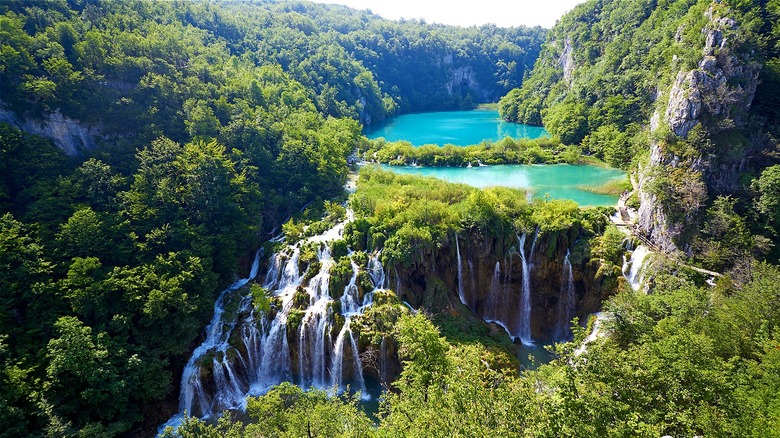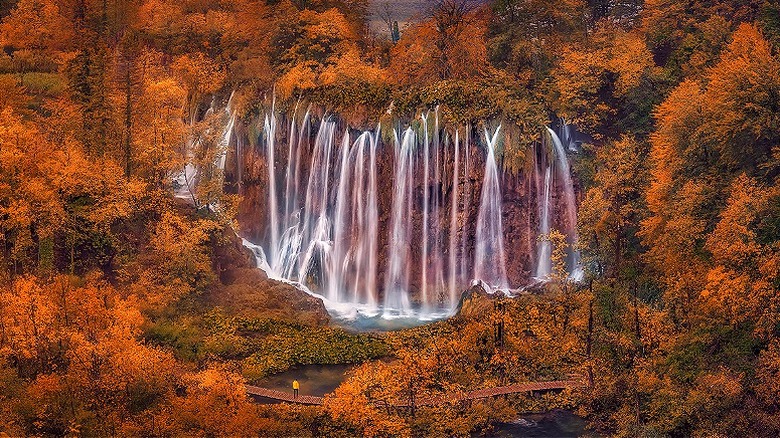Croatia's Lake Region Looks Like Niagara Falls And The Grand Canyon Combined, Per Rick Steves
Croatia is a country with a long and rich history, a culture that rivals neighboring Italy while offering travelers better bang for their buck. But it's also revered among travelers for its beautiful, dramatic landscape and natural wonders, including its idyllic pebble beaches, which boast the cleanest water for swimming in Europe, along with imposing, rugged mountains. No wonder, then, that travel expert Rick Steves waxes lyrical about Croatia, and especially the breathtaking Plitvice Lakes National Park, Croatia's largest national park.
Steves is effusive in his praise of the park, writing in a Facebook post for Rick Steves' Europe, "Imagine Niagara Falls diced and sprinkled over a heavily forested Grand Canyon." That Steves evokes two of the United States' most impressive pieces of natural beauty is high praise indeed, but the travel writer isn't the only person who has fallen in love with Croatia's lush and verdant Plitvice Lakes. Once something of a well-kept Croatian secret, increasingly Plitvice Lakes National Park is becoming a major draw for international travelers, and with so many beautiful features, there's little wonder why it's now one of Croatia's most-visited attractions.
Croatia's mini paradise
For those of us with a taste for the natural world, the details of Plitvice Lakes National Park are positively mouthwatering. The park features 16 pristine lakes, interconnected by rivulets, streams, and, per Visit Croatia, "more than 90 cascades and waterfalls." As Rick Steves described Plitvice, the park is a "misty natural wonderland," which can be explored by visitors via a series of raised walkways specially designed to allow for the best views of these natural wonders.
The naturally formed waterfalls and lakes aren't the only attractions at Plitvice Lakes National Park, though. It's also known for its vast array of wildlife, which includes deer, lynx, bears and wolves, as well as rare birds such as the European honey buzzard, which is critically endangered, as well as the Montagu's harrier, the short-eared owl, and the corncrake. Plitvice Lakes National Park has been listed as a UNESCO World Heritage Site since way back in 1979, and its waters have remained unbelievably clean and luminous ever since, thanks to keen ecological management efforts.
How to get to Plitvice and where to stay
International travelers to Croatia planning to include Plitvice Lakes National Park can fly into the country's capital, bustling and historic Zagreb, from which the park is roughly a two-hour drive. The city of Zadar is another option, which is smaller and with fewer flight connections than the capital but which is slightly closer to Plitvice. A coastal city known for its beauty, Zadar also makes a good base from which to go island hopping in Croatia (like, say, to Hvar, or to Viz, a breathtaking Croatian island offering a blissful beach vacation without the crowds).
Plitvice Lakes National Park contains three hotels — Hotel Plitvice, hotel Bellevue Plitvice, and Jezero Hotel — which are managed by the park itself. However, if you find the rates for a hotel in the park too high, you can also book yourself into Hotel Grabovac, located in the nearby village of the same name, or another nearby family-run guesthouse. Though Rick Steves claims the best of Plitvice can be seen within a few hours, other local guides have claimed that two days are required to truly get to grips with all of the park's beauties in full. Visit Plitvice in spring or fall to experience the waterfalls at their most active thanks to higher rainfall than summer or winter.

